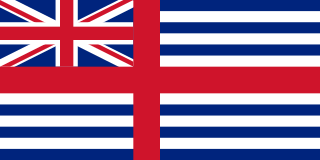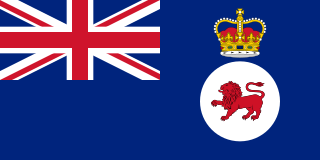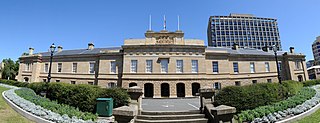
Tasmania is an island state of Australia. It is located 240 kilometres (150 miles) to the south of the Australian mainland, separated from it by the Bass Strait, with the archipelago containing the southernmost point of the country. The state encompasses the main island of Tasmania, the 26th-largest island in the world, and the surrounding 1000 islands. It is Australia's least populous state, with 569,825 residents as of December 2021. The state capital and largest city is Hobart, with around 40 percent of the population living in the Greater Hobart area. This makes it Australia's most decentralised state.

Van Diemen's Land was the colonial name of the island of Tasmania used by the British during the European exploration of Australia in the 19th century. A British settlement was established in Van Diemen's Land in 1803 before it became a separate colony in 1825. Its penal colonies became notorious destinations for the transportation of convicts due to the harsh environment, isolation and reputation for being inescapable. Macquarie Harbour and Port Arthur are among the most well-known penal settlements on the island.

The governor of Tasmania is the representative in the Australian state of Tasmania of the Monarch of Australia, currently King Charles III. The incumbent governor is Barbara Baker, who was appointed in June 2021. The official residence of the governor is Government House located at the Queens Domain in Hobart. As the sovereign predominantly lives outside Tasmania, the governor's primary task is to perform the sovereign's constitutional duties on their behalf.
The history of Tasmania begins at the end of the Last Glacial Period when it is believed that the island was joined to the Australian mainland. Little is known of the human history of the island until the British colonisation of Tasmania in the 19th century.

King Island is an island in the Bass Strait, belonging to the Australian state of Tasmania. It is the largest of three islands known as the New Year Group, and the second-largest island in Bass Strait. The island's population at the 2016 census was 1,585 people, up from 1,566 in 2011. The local government area of the island is the King Island Council.
Richmond is a town in Tasmania about 25 km north-east of Hobart, in the Coal River region, between the Midland Highway and Tasman Highway. At the 2006 census, Richmond had a population of 880.

Bicheno is a locality and town on the east coast of Tasmania, Australia, 185 km north-east of Hobart on the Tasman Highway, with a population of around 950. It is part of the municipality of Glamorgan-Spring Bay. The town is primarily a fishing port and a beach resort.

Longford is a town in the northern midlands of Tasmania, Australia. It lies 145 m above sea level at the convergence of the Macquarie River and the South Esk River, 21 km south of Launceston and a 15-minute drive from the airport. It is just south of the Illawarra Road, a road connecting the Bass and Midland Highways. It has a population of 3,863 and is part of the Northern Midlands Council area. The region is predominantly agricultural, noted for wool, dairy produce and stock breeding.
Henry Hellyer was an English surveyor and architect who was one of the first explorers to visit the rugged interior of the north west of Tasmania, Australia and made the most comprehensive maps of the area up to that time.

The Parliament of Tasmania is the bicameral legislature of the Australian state of Tasmania. It follows a Westminster-derived parliamentary system and consists of the Governor of Tasmania, the Tasmanian House of Assembly, and Tasmanian Legislative Council. Since 1841, both Houses have met in Parliament House, Hobart. The Parliament of Tasmania first met in 1856.

Jørgen Jørgensen was a Danish adventurer during the Age of Revolution. During the action of 2 March 1808, his ship was captured by the British. In 1809 he sailed to Iceland, declared the country independent from Denmark–Norway and pronounced himself its ruler. He intended to found a new republic, following the examples of the United States and the French First Republic. He was also a prolific writer of letters, papers, pamphlets and newspaper articles covering a wide variety of subjects, and for a period was an associate of the famous botanists Joseph Banks and William Jackson Hooker. He left over a hundred written autographs and drawings, most of which are collected in the British Library. Marcus Clarke referred to Jørgensen as "a singularly accomplished fortune wooer—one of the most interesting human comets recorded in history".

John Helder Wedge was a surveyor, explorer and politician in Van Diemen's Land.

Ronald Campbell Gunn, FRS, was a South African-born Australian botanist and politician.

Parliament House, Hobart, located on Salamanca Place in Hobart, Tasmania, Australia, is the meeting place of the Parliament of Tasmania. The building was originally designed as a customs house but changed use in 1841 when Tasmania achieved self-government. The building served both purposes from 1841 to 1904, when the customs offices were relocated.

The Tasmanian emu is an extinct subspecies of emu. It was found in Tasmania, where it had become isolated during the Late Pleistocene. As opposed to the other insular emu taxa, the King Island emu and the Kangaroo Island emu, the population on Tasmania was sizable, meaning that there were no marked effects of small population size as in the other two isolates.

The Van Diemen's Land Company is a farming corporation in the Australian state of Tasmania. It was founded in 1825 and received a royal charter the same year, and was granted 250,000 acres (1,000 km2) in northwest Van Diemen's Land in 1826. The company was a group of London merchants who planned a wool growing venture to supply the needs of the British textile industry.
John Lee Archer was the Civil Engineer and Colonial Architect in Van Diemen's Land, serving from 1827 to 1838. During his tenure, Archer was responsible for all Tasmanian government buildings including those for penal and military purposes.

Fingal is a rural locality in the local government area (LGA) of Break O'Day in the North-east LGA region of Tasmania. The locality is about 56 kilometres (35 mi) south-west of the town of St Helens. The 2016 census recorded a population of 405 for the state suburb of Fingal.

The Colony of Tasmania was a British colony that existed on the island of Tasmania from 1856 until 1901, when it federated together with the five other Australian colonies to form the Commonwealth of Australia. The possibility of the colony was established when the Parliament of the United Kingdom passed the Australian Constitutions Act in 1850, granting the right of legislative power to each of the six Australian colonies. The Legislative Council of Van Diemen's Land drafted a new constitution which they passed in 1854, and it was given royal assent by Queen Victoria in 1855. Later in that year the Privy Council approved the colony changing its name from "Van Diemen's Land" to "Tasmania", and in 1856, the newly elected bicameral parliament of Tasmania sat for the first time, establishing Tasmania as a self-governing colony of the British Empire. Tasmania was often referred to as one of the "most British" colonies of the Empire.
Robbins Island is a 9,900-hectare (24,000-acre) island located in Bass Strait, lying off the northwest coast of Tasmania, Australia. The island, separated from the Tasmanian mainland by a highly tidal area known as Robbins Passage, lies south to the adjacent Walker Island.

















